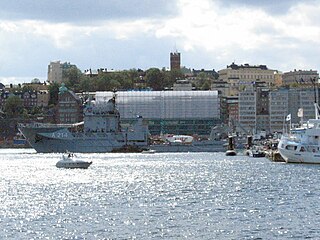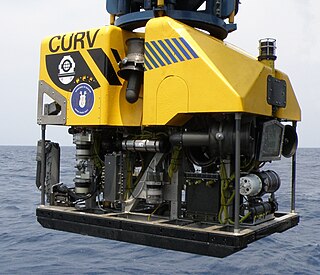
A submarine is a watercraft capable of independent operation underwater. It differs from a submersible, which has more limited underwater capability. The term is also sometimes used historically or colloquially to refer to remotely operated vehicles and robots, as well as medium-sized or smaller vessels, such as the midget submarine and the wet sub. Submarines are referred to as boats rather than ships irrespective of their size.

A remotely operated vehicle (ROV) is a free-swimming submersible craft used to perform tasks such as valve operations, hydraulic functions and other general tasks within the subsea oil and gas industry. ROVs can also carry tooling packages for undertaking specific tasks such as pull-in and connection of flexible flowlines and umbilicals, and component replacement.

A submersible is an underwater vehicle which needs to be transported and supported by a larger watercraft or platform. This distinguishes submersibles from submarines, which are self-supporting and capable of prolonged independent operation at sea.

A midget submarine is any submarine under 150 tons, typically operated by a crew of one or two but sometimes up to six or nine, with little or no on-board living accommodation. They normally work with mother ships, from which they are launched and recovered and which provide living accommodation for the crew and support staff.

HMS Challenger was a Royal Navy diving support vessel, operational from 1984 to 1990.

AS-28 is a Priz-class deep-submergence rescue vehicle of the Russian Navy, which entered service in 1986. It was designed for submarine rescue operations by the Lazurit Design Bureau in Nizhny Novgorod. It is 13.5 m (44 ft) long, 5.7 m (19 ft) high, and can operate up to a depth of 1,000 m (3,300 ft).

The Scorpio is a brand of underwater submersible Remotely Operated Vehicle (ROV) manufactured by Perry Tritech used by sub-sea industries such as the oil industry for general operations, and by the Royal Navy and the United States Navy for submarine rescue services. Originally developed by AMETEK Straza of El Cajon, United States, they were subsequently developed by Perry Tritech. Although the design of the original Scorpio is over several decades old, it forms the basis for a current generation of Scorpio-branded ROVs. Scorpio ROVs are named in a sequence following the order of manufacture, such as "Scorpio 17" or "Scorpio 45" which refer to specific ROVs.

A deep-submergence rescue vehicle (DSRV) is a type of deep-submergence vehicle used for rescue of downed submarines and clandestine missions. While DSRV is the term most often used by the United States Navy, other nations have different designations for their vehicles.

Unmanned underwater vehicles (UUV), sometimes known as underwater drones, are submersible vehicles that can operate underwater without a human occupant. These vehicles may be divided into two categories: remotely operated underwater vehicles (ROUVs) and autonomous underwater vehicles (AUVs). ROUVs are remotely controlled by a human operator. AUVs are automated and operate independently of direct human input.

The NATO Submarine Rescue System (NSRS) is a tri-national project to develop an international submarine rescue system. The system provides a rescue capability primarily to the partner nations of France, Norway and the United Kingdom, but also to NATO and allied nations and to any submarine equipped with a suitable mating surface around its hatches.
Australian Submarine Rescue Vehicle Remora was a submarine rescue vehicle used by the Royal Australian Navy (RAN) between 1995 and 2006. The name comes from the remora, a small fish that can attach itself to larger marine life, and has the backronym "Really Excellent Method of Rescuing Aussies".
Subsea technology involves fully submerged ocean equipment, operations, or applications, especially when some distance offshore, in deep ocean waters, or on the seabed. The term subsea is frequently used in connection with oceanography, marine or ocean engineering, ocean exploration, remotely operated vehicle (ROVs) autonomous underwater vehicles (AUVs), submarine communications or power cables, seafloor mineral mining, oil and gas, and offshore wind power.

Pisces-class submersibles are three-person research deep-submergence vehicles designed and built by Hyco International Hydrodynamics of North Vancouver in British Columbia with a maximum operating depth of 2,000 m (6,560 ft). The vehicles have multiple view ports and sample collecting, environmental sensing, and instrument placement capabilities. The pressure hull has a 7 ft (2.1 m) inside diameter and is made of HY-100 steel with three forward-looking acrylic windows, 6 in (15 cm) in diameter. Designed by Allan Trice, the Pisces series of submersibles were representative of crewed submersibles built in the late 1960s and were proven workhorses in offshore exploration and oceanographic research. Pisces II was the first production model of the design and was completed in 1968, with nine more Pisces submarines built before the manufacturer went out of business in the late 1970s.

CURV-III was the fourth generation of the United States Navy Cable-controlled Undersea Recovery Vehicle (CURV). CURV was a prototype for remotely operated underwater vehicles and a pioneer for teleoperation. It became famous in 1966 when CURV-I was used to recover a hydrogen bomb from the floor of the Mediterranean Sea. In 1973, CURV-III performed the deepest underwater rescue in history when it rescued two men 1,575 feet (480 m) from the ocean surface who were stranded 76 hours in the submersible Pisces III with just minutes of air remaining. The CURV-III became known in the Great Lakes region in 1976 when it was used to survey the wreck of the SS Edmund Fitzgerald. CURV-21 is the current generation that replaced CURV-III.

URF is the Royal Swedish Navy’s Submarine Rescue Vessel.

The rescue of Roger Mallinson and Roger Chapman occurred between 29 August and 1 September 1973 after their Vickers Oceanics small submersible Pisces III was trapped on the seabed at a depth of 1,575 feet (480 m), 150 miles (240 km) off Ireland in the Celtic Sea. The 76-hour multinational rescue effort resulted in the deepest successful submarine rescue in history.
Roger Ralph Chapman, CBE was a British submariner and businessman. A former Royal Navy lieutenant, Chapman was one of the two survivors of the deepest sub rescue in history in 1973, when his small submersible Pisces III was lifted to the surface from a depth of 1,575 ft. The founder of the first all-electric ROV company, he later went on to designing subs designed for rescue operations. Using one of his subs, he successfully rescued 7 Russian sailors in 2005 for which he was awarded CBE in 2006.

The LR7 is a deep-submergence rescue vehicle (DSRV) of the People's Republic of China's People's Liberation Army Navy (PLAN). It was built by Perry Slingsby of Britain and is a development of the LR5 DSRV. The LR7 entered service in 2009.
Submarine rescue is the process of locating a sunk submarine with survivors on board, and bringing the survivors to safety. This may be done by recovering the vessel to the surface first, or by transferring the trapped personnel to a rescue bell or deep-submergence rescue vehicle to bring them to the surface. Submarine rescue may be done at pressures between ambient at depth, and sea level atmospheric pressure, depending on the condition of the distressed vessel and the equipment used for the rescue. Self-rescue of submarine personnel by buoyant free ascent at ambient pressure is considered submarine escape. Survivors may require recompression treatment for decompression illness.

CURV-21 is a remotely operated underwater vehicles (ROV) of the United States Navy designed to meet its deep ocean salvage requirements down to a maximum depth of 20,000 feet (6,100 m) of seawater.
















